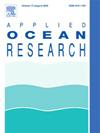智能浮动城市波浪能转换器中球茎底浮标的同构弗劳德标度方法
IF 4.3
2区 工程技术
Q1 ENGINEERING, OCEAN
引用次数: 0
摘要
测试具有增强功率吸收的全尺寸点吸收浮标具有挑战性,对于提高其在智能浮动城市和海洋基础设施中的应用可行性至关重要。球根底(BB)浮标在点吸收波能转换器(PA-WEC)中具有良好的流体力学性能和吸能性能。他们的实验验证需要自适应缩放算法,以方便模型规模的测试。本研究采用了最先进的理论算法,将弗劳德标度与同构浮标设计方法相结合,促进了模型尺度测试,以研究在相同条件下部署和实验测试时,BB浮标是否与参考半球底(CHS)浮标具有相同的效率。在实验室尺度的波浪水槽中对增材制造的比例浮标模型进行了规则波(内外共振)和不规则波的测试,并在原型尺度上进行了性能预测的相似性分析。还建立了可行性研究,以证明BB浮标在实时PA-WECs中的应用。在规则波和不规则波中,BB浮标在共振和无共振情况下的表现都优于CHS浮标,证明它们可以永久取代CHS浮标。在相同的部署和测试设置下,模型比例的BB浮标比没有共振的参考浮标表现出20 - 27%的升沉运动。一个全尺寸的BB浮标可以比参考浮标吸收更大的波浪能。案例研究表明,从chs到bb的转变导致WEC捕获宽度比增加35%。WEC与5G-IoT和LSTM网络相结合,可以在智能浮动城市中促进自供电和自感知的海洋应用。本文章由计算机程序翻译,如有差异,请以英文原文为准。
An isomorphic Froude scaling approach to bulbous-bottomed buoys in wave energy converters for smart floating cities
Testing full-scale point absorber buoys with enhanced power absorption is challenging and crucial to improving their viability for applications in smart floating cities and marine infrastructure. Bulbous-bottomed (BB) buoys are efficient in hydrodynamics and power absorption for point absorber wave energy converters (PA-WEC). Their experimental validation demands adaptable scaling algorithms to facilitate model-scale tests. This study utilizes a state-of-the-art theoretical algorithm by combining Froude scaling with an isomorphic buoy design approach, facilitating model-scale tests to investigate whether the BB buoys would equally be efficient compared to the reference hemispherical-bottomed (C![]() HS) buoy when deployed and tested experimentally under identical conditions. Additively manufactured scaled buoy models were tested in a laboratory-scale wave flume in both regular waves (inside and outside resonance) and irregular waves, followed by a similarity analysis for performance prediction on the prototype scale. A feasibility study was also established to justify the BB buoy application in real-time PA-WECs. The BB buoys outperformed the C
HS) buoy when deployed and tested experimentally under identical conditions. Additively manufactured scaled buoy models were tested in a laboratory-scale wave flume in both regular waves (inside and outside resonance) and irregular waves, followed by a similarity analysis for performance prediction on the prototype scale. A feasibility study was also established to justify the BB buoy application in real-time PA-WECs. The BB buoys outperformed the C![]() HS buoys within and without resonance in regular and irregular waves, justifying that they can replace them for good. Under the same deployment and test settings, the model-scale BB buoy exhibited a 2027 % greater heave motion than the reference without resonance. A full-scale BB buoy could absorb significantly greater wave power than the reference. The case study showed that a C
HS buoys within and without resonance in regular and irregular waves, justifying that they can replace them for good. Under the same deployment and test settings, the model-scale BB buoy exhibited a 2027 % greater heave motion than the reference without resonance. A full-scale BB buoy could absorb significantly greater wave power than the reference. The case study showed that a C![]() HS-to-BB transition resulted in a 35 % rise in the capture width ratio of a WEC. The WEC, combined with a 5G-IoT and LSTM network, could facilitate self-powered and self-sensing marine applications in a smart floating city.
HS-to-BB transition resulted in a 35 % rise in the capture width ratio of a WEC. The WEC, combined with a 5G-IoT and LSTM network, could facilitate self-powered and self-sensing marine applications in a smart floating city.
求助全文
通过发布文献求助,成功后即可免费获取论文全文。
去求助
来源期刊

Applied Ocean Research
地学-工程:大洋
CiteScore
8.70
自引率
7.00%
发文量
316
审稿时长
59 days
期刊介绍:
The aim of Applied Ocean Research is to encourage the submission of papers that advance the state of knowledge in a range of topics relevant to ocean engineering.
 求助内容:
求助内容: 应助结果提醒方式:
应助结果提醒方式:


